6.15: Inscribed Quadrilaterals in Circles
- Page ID
- 5040
\( \newcommand{\vecs}[1]{\overset { \scriptstyle \rightharpoonup} {\mathbf{#1}} } \)
\( \newcommand{\vecd}[1]{\overset{-\!-\!\rightharpoonup}{\vphantom{a}\smash {#1}}} \)
\( \newcommand{\dsum}{\displaystyle\sum\limits} \)
\( \newcommand{\dint}{\displaystyle\int\limits} \)
\( \newcommand{\dlim}{\displaystyle\lim\limits} \)
\( \newcommand{\id}{\mathrm{id}}\) \( \newcommand{\Span}{\mathrm{span}}\)
( \newcommand{\kernel}{\mathrm{null}\,}\) \( \newcommand{\range}{\mathrm{range}\,}\)
\( \newcommand{\RealPart}{\mathrm{Re}}\) \( \newcommand{\ImaginaryPart}{\mathrm{Im}}\)
\( \newcommand{\Argument}{\mathrm{Arg}}\) \( \newcommand{\norm}[1]{\| #1 \|}\)
\( \newcommand{\inner}[2]{\langle #1, #2 \rangle}\)
\( \newcommand{\Span}{\mathrm{span}}\)
\( \newcommand{\id}{\mathrm{id}}\)
\( \newcommand{\Span}{\mathrm{span}}\)
\( \newcommand{\kernel}{\mathrm{null}\,}\)
\( \newcommand{\range}{\mathrm{range}\,}\)
\( \newcommand{\RealPart}{\mathrm{Re}}\)
\( \newcommand{\ImaginaryPart}{\mathrm{Im}}\)
\( \newcommand{\Argument}{\mathrm{Arg}}\)
\( \newcommand{\norm}[1]{\| #1 \|}\)
\( \newcommand{\inner}[2]{\langle #1, #2 \rangle}\)
\( \newcommand{\Span}{\mathrm{span}}\) \( \newcommand{\AA}{\unicode[.8,0]{x212B}}\)
\( \newcommand{\vectorA}[1]{\vec{#1}} % arrow\)
\( \newcommand{\vectorAt}[1]{\vec{\text{#1}}} % arrow\)
\( \newcommand{\vectorB}[1]{\overset { \scriptstyle \rightharpoonup} {\mathbf{#1}} } \)
\( \newcommand{\vectorC}[1]{\textbf{#1}} \)
\( \newcommand{\vectorD}[1]{\overrightarrow{#1}} \)
\( \newcommand{\vectorDt}[1]{\overrightarrow{\text{#1}}} \)
\( \newcommand{\vectE}[1]{\overset{-\!-\!\rightharpoonup}{\vphantom{a}\smash{\mathbf {#1}}}} \)
\( \newcommand{\vecs}[1]{\overset { \scriptstyle \rightharpoonup} {\mathbf{#1}} } \)
\( \newcommand{\vecd}[1]{\overset{-\!-\!\rightharpoonup}{\vphantom{a}\smash {#1}}} \)
\(\newcommand{\avec}{\mathbf a}\) \(\newcommand{\bvec}{\mathbf b}\) \(\newcommand{\cvec}{\mathbf c}\) \(\newcommand{\dvec}{\mathbf d}\) \(\newcommand{\dtil}{\widetilde{\mathbf d}}\) \(\newcommand{\evec}{\mathbf e}\) \(\newcommand{\fvec}{\mathbf f}\) \(\newcommand{\nvec}{\mathbf n}\) \(\newcommand{\pvec}{\mathbf p}\) \(\newcommand{\qvec}{\mathbf q}\) \(\newcommand{\svec}{\mathbf s}\) \(\newcommand{\tvec}{\mathbf t}\) \(\newcommand{\uvec}{\mathbf u}\) \(\newcommand{\vvec}{\mathbf v}\) \(\newcommand{\wvec}{\mathbf w}\) \(\newcommand{\xvec}{\mathbf x}\) \(\newcommand{\yvec}{\mathbf y}\) \(\newcommand{\zvec}{\mathbf z}\) \(\newcommand{\rvec}{\mathbf r}\) \(\newcommand{\mvec}{\mathbf m}\) \(\newcommand{\zerovec}{\mathbf 0}\) \(\newcommand{\onevec}{\mathbf 1}\) \(\newcommand{\real}{\mathbb R}\) \(\newcommand{\twovec}[2]{\left[\begin{array}{r}#1 \\ #2 \end{array}\right]}\) \(\newcommand{\ctwovec}[2]{\left[\begin{array}{c}#1 \\ #2 \end{array}\right]}\) \(\newcommand{\threevec}[3]{\left[\begin{array}{r}#1 \\ #2 \\ #3 \end{array}\right]}\) \(\newcommand{\cthreevec}[3]{\left[\begin{array}{c}#1 \\ #2 \\ #3 \end{array}\right]}\) \(\newcommand{\fourvec}[4]{\left[\begin{array}{r}#1 \\ #2 \\ #3 \\ #4 \end{array}\right]}\) \(\newcommand{\cfourvec}[4]{\left[\begin{array}{c}#1 \\ #2 \\ #3 \\ #4 \end{array}\right]}\) \(\newcommand{\fivevec}[5]{\left[\begin{array}{r}#1 \\ #2 \\ #3 \\ #4 \\ #5 \\ \end{array}\right]}\) \(\newcommand{\cfivevec}[5]{\left[\begin{array}{c}#1 \\ #2 \\ #3 \\ #4 \\ #5 \\ \end{array}\right]}\) \(\newcommand{\mattwo}[4]{\left[\begin{array}{rr}#1 \amp #2 \\ #3 \amp #4 \\ \end{array}\right]}\) \(\newcommand{\laspan}[1]{\text{Span}\{#1\}}\) \(\newcommand{\bcal}{\cal B}\) \(\newcommand{\ccal}{\cal C}\) \(\newcommand{\scal}{\cal S}\) \(\newcommand{\wcal}{\cal W}\) \(\newcommand{\ecal}{\cal E}\) \(\newcommand{\coords}[2]{\left\{#1\right\}_{#2}}\) \(\newcommand{\gray}[1]{\color{gray}{#1}}\) \(\newcommand{\lgray}[1]{\color{lightgray}{#1}}\) \(\newcommand{\rank}{\operatorname{rank}}\) \(\newcommand{\row}{\text{Row}}\) \(\newcommand{\col}{\text{Col}}\) \(\renewcommand{\row}{\text{Row}}\) \(\newcommand{\nul}{\text{Nul}}\) \(\newcommand{\var}{\text{Var}}\) \(\newcommand{\corr}{\text{corr}}\) \(\newcommand{\len}[1]{\left|#1\right|}\) \(\newcommand{\bbar}{\overline{\bvec}}\) \(\newcommand{\bhat}{\widehat{\bvec}}\) \(\newcommand{\bperp}{\bvec^\perp}\) \(\newcommand{\xhat}{\widehat{\xvec}}\) \(\newcommand{\vhat}{\widehat{\vvec}}\) \(\newcommand{\uhat}{\widehat{\uvec}}\) \(\newcommand{\what}{\widehat{\wvec}}\) \(\newcommand{\Sighat}{\widehat{\Sigma}}\) \(\newcommand{\lt}{<}\) \(\newcommand{\gt}{>}\) \(\newcommand{\amp}{&}\) \(\definecolor{fillinmathshade}{gray}{0.9}\)Quadrilaterals with every vertex on a circle and opposite angles that are supplementary.
An inscribed polygon is a polygon where every vertex is on the circle, as shown below.

For inscribed quadrilaterals in particular, the opposite angles will always be supplementary.
Inscribed Quadrilateral Theorem: A quadrilateral can be inscribed in a circle if and only if the opposite angles are supplementary.
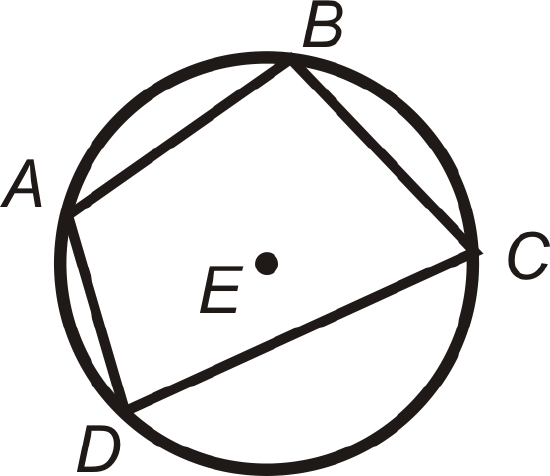
If \(ABCD\) is inscribed in \(\bigodot E\), then \(m\angle A+m\angle C=180^{\circ}\) and \(m\angle B+m\angle D=180^{\circ}\). Conversely, If \(m\angle A+m\angle C=180^{\circ}\) and \(m\angle B+m\angle D=180^{\circ}\), then \(ABCD\) is inscribed in \(\bigodot E\).
What if you were given a circle with a quadrilateral inscribed in it? How could you use information about the arcs formed by the quadrilateral and/or the quadrilateral's angle measures to find the measure of the unknown quadrilateral angles?
Example \(\PageIndex{1}\)
-
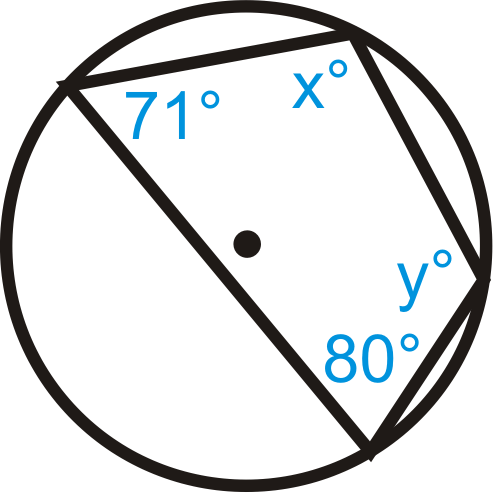
Figure \(\PageIndex{3}\) -
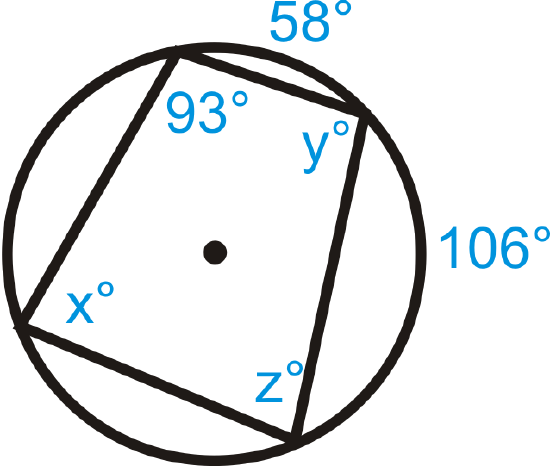
Figure \(\PageIndex{4}\)
Solution
- \(\begin{aligned}
x+80^{\circ}&=180^{\circ} \qquad& y+71^{\circ}&=180^{\circ} \\
x&=100^{\circ} & y&=109^{\circ}
\end{aligned}\)
- \(\begin{aligned}
z+93^{\circ} &=180^{\circ} & x&=\frac{1}{2}\left(58^{\circ}+106^{\circ}\right) & y+82^{\circ}&=180^{\circ} \\
z &=87^{\circ} & x &=82^{\circ} & y&=98^{\circ}
\end{aligned}\)
Example \(\PageIndex{2}\)
Find \(x\) and \(y\) in the picture below.
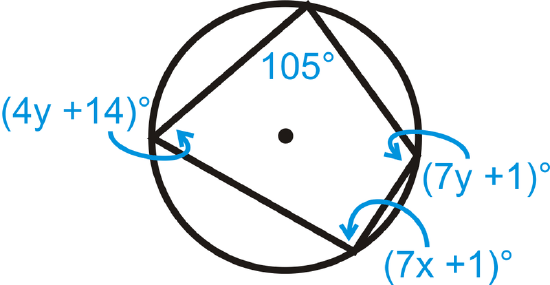
Solution
\(\begin{array}{rlrl}
(7 x+1)^{\circ}+105^{\circ} & =180^{\circ} & (4 y+14)^{\circ}+(7 y+1)^{\circ} & =180^{\circ} \\
7 x+106^{\circ} & =180^{\circ} & 11 y+15^{\circ} & =180^{\circ} \\
7 x & =74 & 11 y & =165 \\
x & =10.57 & y&=15
\end{array}\)
Example \(\PageIndex{3}\)
Find the values of x and y in \(\bigodot A\).
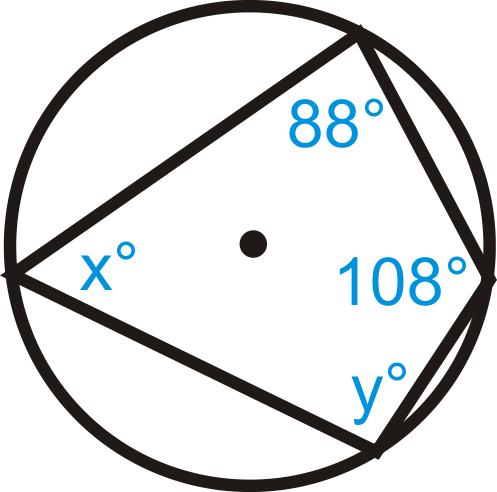
Solution
Use the Inscribed Quadrilateral Theorem. \(x^{\circ}+108^{\circ}=180^{\circ}\) so \(x=72^{\circ}\). Similarly, \(y^{\circ}+88^{\circ}=180^{\circ}\) so \(y=92^{\circ}\).
Example \(\PageIndex{4}\)
Quadrilateral \(ABCD\) is inscribed in \(\bigodot E\). Find \(m\angle A\), \(m\angle B\), \(m\angle C\), and \(m\angle D\).
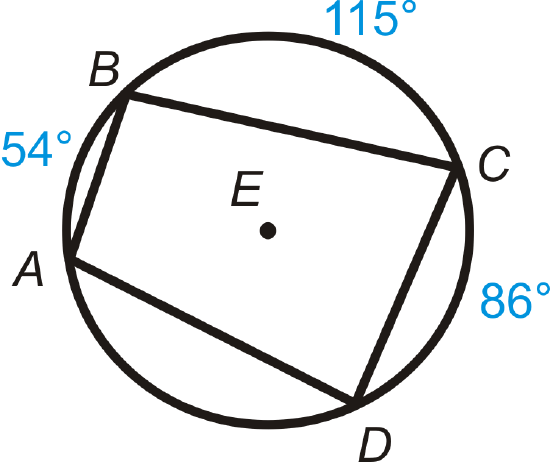
Solution
First, note that \(m\widehat{AD}=105^{\circ}\) because the complete circle must add up to \(360^{\circ}\).
\(\begin{aligned}m\angle A&=\dfrac{1}{2}m\widehat{BD}=12(115+86)=100.5^{\circ} \\ m\angle B&=\dfrac{1}{2}m\widehat{AC}=12(86+105)=95.5^{\circ} \\ m\angle C&=180^{\circ}−m\angle A=180^{\circ}−100.5^{\circ}=79.5^{\circ} \\ m\angle D&=180^{\circ}−m\angle B=180^{\circ}−95.5^{\circ}=84.5^{\circ}\end{aligned}\)
Review
Fill in the blanks.
- A(n) _______________ polygon has all its vertices on a circle.
- The _____________ angles of an inscribed quadrilateral are ________________.
Quadrilateral \(ABCD\) is inscribed in \(\bigodot E\). Find:
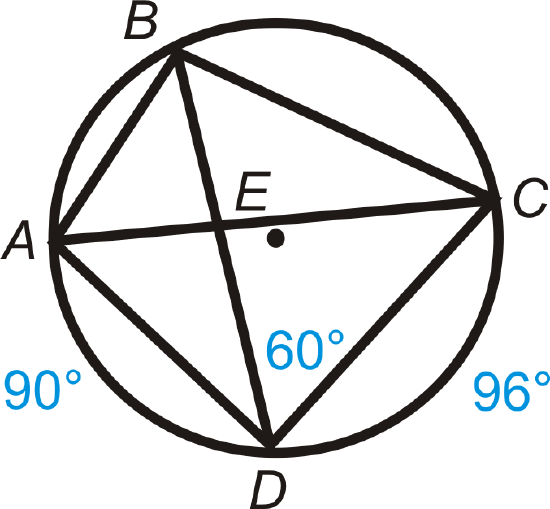
- \(m\angle DBC\)
- \(m\widehat{BC}\)
- \(m\widehat{AB}\)
- \(m\angle ACD\)
- \(m\angle ADC\)
- \(m\angle ACB\)
Find the value of \(x\) and/or \(y\) in \(\bigodot A\).
-
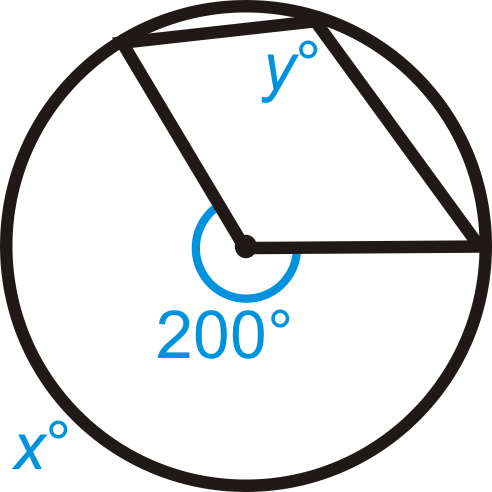
Figure \(\PageIndex{9}\) -
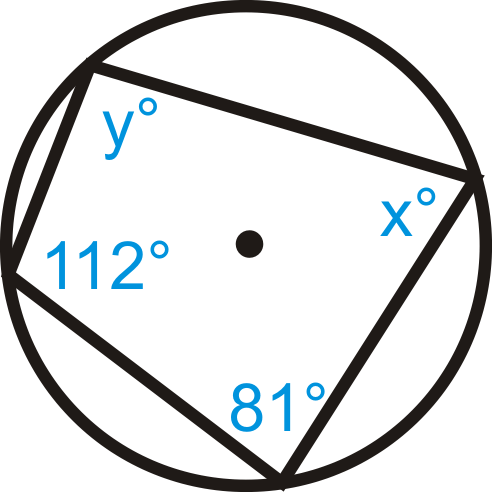
Figure \(\PageIndex{10}\) -
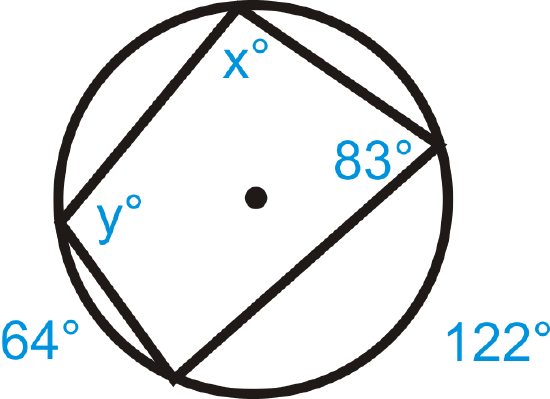
Figure \(\PageIndex{11}\)
Solve for \(x\).
-
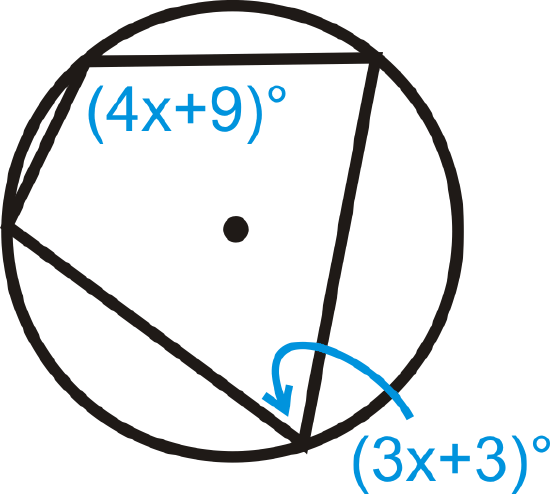
Figure \(\PageIndex{12}\) -
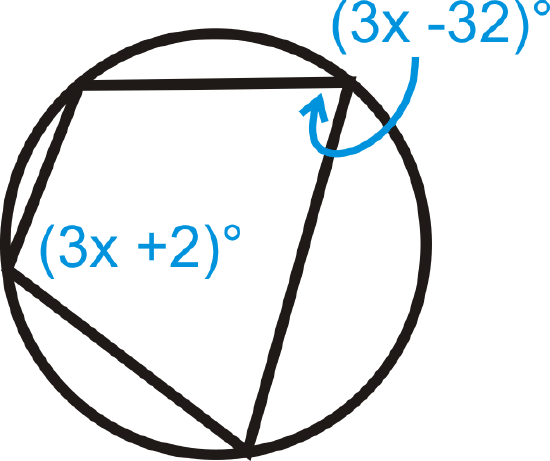
Figure \(\PageIndex{13}\)
Vocabulary
| Term | Definition |
|---|---|
| central angle | An angle formed by two radii and whose vertex is at the center of the circle. |
| chord | A line segment whose endpoints are on a circle. |
| circle | The set of all points that are the same distance away from a specific point, called the center. |
| diameter | A chord that passes through the center of the circle. The length of a diameter is two times the length of a radius. |
| inscribed angle | An angle with its vertex on the circle and whose sides are chords. |
| intercepted arc | The arc that is inside an inscribed angle and whose endpoints are on the angle. |
| radius | The distance from the center to the outer rim of a circle. |
| Inscribed Polygon | An inscribed polygon is a polygon with every vertex on a given circle. |
| Inscribed Quadrilateral Theorem | The Inscribed Quadrilateral Theorem states that a quadrilateral can be inscribed in a circle if and only if the opposite angles of the quadrilateral are supplementary. |
| Cyclic Quadrilaterals | A cyclic quadrilateral is a quadrilateral that can be inscribed in a circle. |
Additional Resources
Interactive Element
Video: Inscribed Quadrilaterals in Circles Principles - Basic
Activities: Inscribed Quadrilaterals in Circles Discussion Questions
Study Aids: Inscribed in Circles Study Guide
Practice: Inscribed Quadrilaterals in Circles
Real World: Sunrise at Stonehenge

